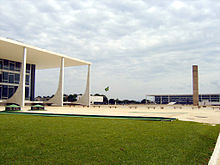Place of the three powers
The Square of the Three Powers (Portuguese: Praça dos Três Poderes ) is a square at the western end of the Eixo Monumental in Brasília .
Naming
The name of the square is derived from the function of the buildings surrounding it in the original plan:
- Palácio do Planalto - Palace of the President as executive
- Palácio Nereu Ramos - Building of the National Congress of Brazil as the legislature
- Supremo Tribunal Federal - Building of the Supreme Court of the Brazilian Federation as a judicial branch
Building history and design
The Plano Piloto for the establishment of the city of Brasília already envisaged the union of the three powers in one place at the west end of the east-west main axis of the city.
The design for the design of the square comes from Oscar Niemeyer and Lúcio Costa , the approximately 120 × 220 meter square without any planting should increase the special spatial effect. In addition to the surrounding buildings, the square is characterized by some first-class modern sculptures:
- A Justiça ( Justitia ) - Alfredo Ceschiatti
- Os Guerreiros ( The Warriors ) - Bruno Giorgi
- O Pombal ( The Dovecote ) - Oscar Niemeyer
The construction of the surrounding buildings began as early as 1958. In 1985 the construction of the Panteão da Pátria e da Liberdade Tancredo Neves began on the previously undeveloped west side of the square , which was opened on September 7, 1986. Also on the west side of the square is a flagpole designed by Sérgio Bernardes , on which a 286 m² flag of Brazil flies. Underneath these structures is the Espaço Oscar Niemeyer , a cylindrical exhibition building that shows sketches, designs and photos of the architect's work on an area of 432 m².
On the east side of the square, where a grove of royal palms was laid out as a transition to the Congresso Nacional , is the entrance to the Museu Histórico de Brasília located below the square , in whose facade the sculpture of the head of Juscelino Kubitschek was integrated. Also below the square is the Espaço Lúcio Costa , which shows a 179 m² model of the city of Brasília.
Coordinates: 15 ° 48 ′ 2.7 ″ S , 47 ° 51 ′ 40.7 ″ W.

